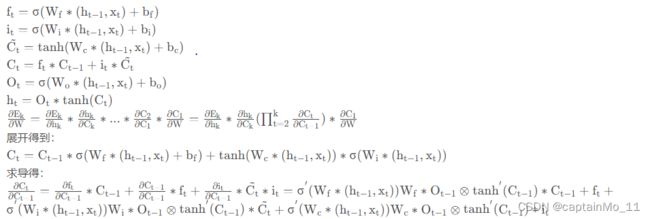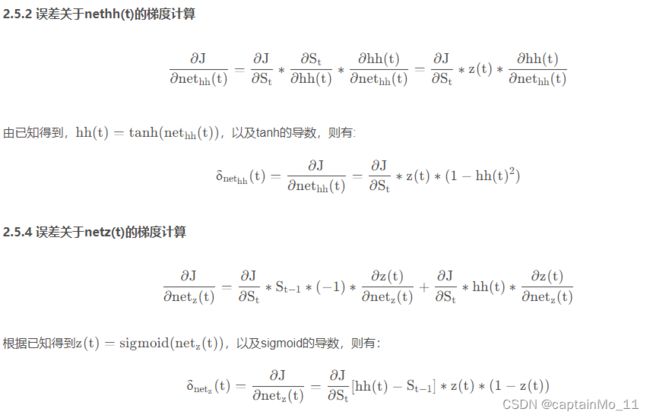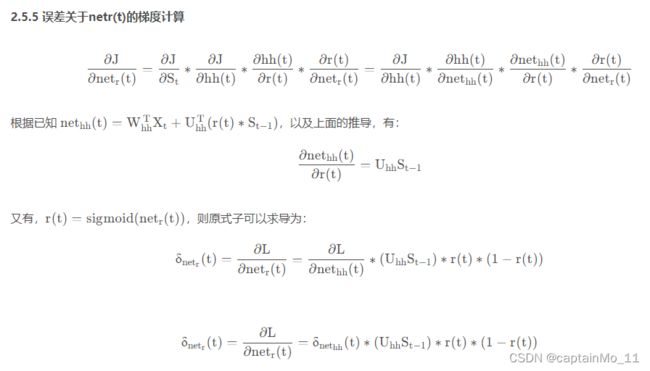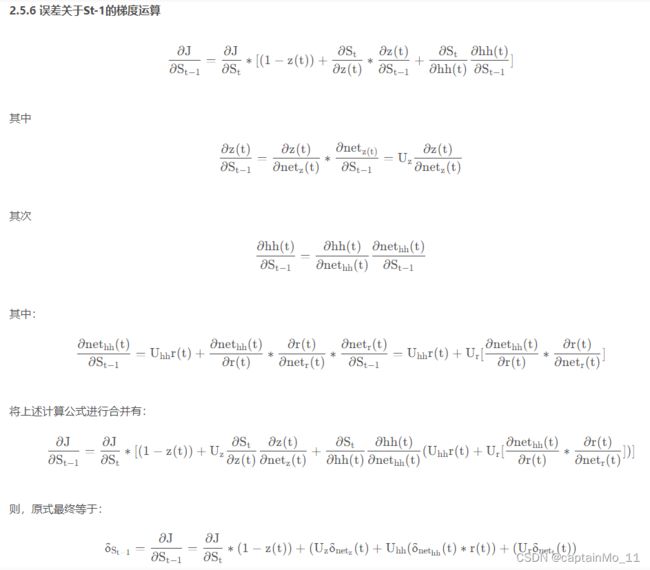神经网络与深度学习作业10:(LSTM | GRU)
习题6-3 当使用公式(6.50)作为循环神经网络得状态更新公式时,分析其可能存在梯度爆炸的原因并给出解决办法.
公式(6.50)为:![]()
在计算误差项时,可能会出现梯度过大的情况,解决办法为:使用长短期神经网络。
习题6-4推导LSTM 网络中参数的梯度,并分析其避免梯度消失的效果.
其中E EE为损失函数,由于LSTM中通过门控机制解决梯度问题,遗忘门,输入门和输出门是非0就是1的,并且三者之间都是相加关系,梯度能够很好的在LSTM传递,减轻了梯度消失发生的概率,门为0时,上一刻的信息对当前时刻无影响,没必要接受传递更新参数了。
习题6-5推导GRU网络中参数的梯度,并分析其避免梯度消失的效果. (选做)
分析:
把LSTM的input gate和forget gate整合成一个update gate,也是通过gate机制来控制梯度:
附加题 6-1P 什么时候应该用GRU? 什么时候用LSTM?
![]()
概括的来说,LSTM和GRU都能通过各种Gate将重要特征保留,保证其在long-term 传播的时候也不会被丢失。
![]()
可以看出,标准LSTM和GRU的差别并不大,但是都比tanh要明显好很多,所以在选择标准LSTM或者GRU的时候还要看具体的任务是什么。
使用LSTM的原因之一是解决RNN Deep Network的Gradient错误累积太多,以至于Gradient归零或者成为无穷大,所以无法继续进行优化的问题。GRU的构造更简单:比LSTM少一个gate,这样就少几个矩阵乘法。在训练数据很大的情况下GRU能节省很多时间。
附加题 6-2P LSTM BP推导,并用Numpy实现
import numpy as np
import torch
def sigmoid(x):
return 1 / (1 + np.exp(-x))
class LSTMCell:
def __init__(self, weight_ih, weight_hh, bias_ih, bias_hh):
self.weight_ih = weight_ih
self.weight_hh = weight_hh
self.bias_ih = bias_ih
self.bias_hh = bias_hh
self.dc_prev = None
self.dh_prev = None
self.weight_ih_grad_stack = []
self.weight_hh_grad_stack = []
self.bias_ih_grad_stack = []
self.bias_hh_grad_stack = []
self.x_stack = []
self.dx_list = []
self.dh_prev_stack = []
self.h_prev_stack = []
self.c_prev_stack = []
self.h_next_stack = []
self.c_next_stack = []
self.input_gate_stack = []
self.forget_gate_stack = []
self.output_gate_stack = []
self.cell_memory_stack = []
def __call__(self, x, h_prev, c_prev):
a_vector = np.dot(x, self.weight_ih.T) + np.dot(h_prev, self.weight_hh.T)
a_vector += self.bias_ih + self.bias_hh
h_size = np.shape(h_prev)[1]
a_i = a_vector[:, h_size * 0:h_size * 1]
a_f = a_vector[:, h_size * 1:h_size * 2]
a_c = a_vector[:, h_size * 2:h_size * 3]
a_o = a_vector[:, h_size * 3:]
input_gate = sigmoid(a_i)
forget_gate = sigmoid(a_f)
cell_memory = np.tanh(a_c)
output_gate = sigmoid(a_o)
c_next = (forget_gate * c_prev) + (input_gate * cell_memory)
h_next = output_gate * np.tanh(c_next)
self.x_stack.append(x)
self.h_prev_stack.append(h_prev)
self.c_prev_stack.append(c_prev)
self.c_next_stack.append(c_next)
self.h_next_stack.append(h_next)
self.input_gate_stack.append(input_gate)
self.forget_gate_stack.append(forget_gate)
self.output_gate_stack.append(output_gate)
self.cell_memory_stack.append(cell_memory)
self.dc_prev = np.zeros_like(c_next)
self.dh_prev = np.zeros_like(h_next)
return h_next, c_next
def backward(self, dh_next):
x_stack = self.x_stack.pop()
h_prev = self.h_prev_stack.pop()
c_prev = self.c_prev_stack.pop()
c_next = self.c_next_stack.pop()
input_gate = self.input_gate_stack.pop()
forget_gate = self.forget_gate_stack.pop()
output_gate = self.output_gate_stack.pop()
cell_memory = self.cell_memory_stack.pop()
dh = dh_next + self.dh_prev
d_tanh_c = dh * output_gate * (1 - np.square(np.tanh(c_next)))
dc = d_tanh_c + self.dc_prev
dc_prev = dc * forget_gate
self.dc_prev = dc_prev
d_input_gate = dc * cell_memory
d_forget_gate = dc * c_prev
d_cell_memory = dc * input_gate
d_output_gate = dh * np.tanh(c_next)
d_ai = d_input_gate * input_gate * (1 - input_gate)
d_af = d_forget_gate * forget_gate * (1 - forget_gate)
d_ao = d_output_gate * output_gate * (1 - output_gate)
d_ac = d_cell_memory * (1 - np.square(cell_memory))
da = np.concatenate((d_ai, d_af, d_ac, d_ao), axis=1)
dx = np.dot(da, self.weight_ih)
dh_prev = np.dot(da, self.weight_hh)
self.dh_prev = dh_prev
self.dx_list.insert(0, dx)
self.dh_prev_stack.append(dh_prev)
self.weight_ih_grad_stack.append(np.dot(da.T, x_stack))
self.weight_hh_grad_stack.append(np.dot(da.T, h_prev))
db = np.sum(da, axis=0)
self.bias_ih_grad_stack.append(db)
self.bias_hh_grad_stack.append(db)
return dh_prev
np.random.seed(123)
torch.random.manual_seed(123)
np.set_printoptions(precision=6, suppress=True)
lstm_torch = torch.nn.LSTMCell(2, 3).double()
lstm_numpy = LSTMCell(lstm_torch.weight_ih.data.numpy(),
lstm_torch.weight_hh.data.numpy(),
lstm_torch.bias_ih.data.numpy(),
lstm_torch.bias_hh.data.numpy())
x_numpy = np.random.random((4, 2))
x_torch = torch.tensor(x_numpy, requires_grad=True)
h_numpy = np.random.random((4, 3))
h_torch = torch.tensor(h_numpy, requires_grad=True)
c_numpy = np.random.random((4, 3))
c_torch = torch.tensor(c_numpy, requires_grad=True)
dh_numpy = np.random.random((4, 3))
dh_torch = torch.tensor(dh_numpy, requires_grad=True)
h_numpy, c_numpy = lstm_numpy(x_numpy, h_numpy, c_numpy)
h_torch, c_torch = lstm_torch(x_torch, (h_torch, c_torch))
h_torch.backward(dh_torch)
dh_numpy = lstm_numpy.backward(dh_numpy)
print("h_numpy :\n", h_numpy)
print("h_torch :\n", h_torch.data.numpy())
print("---------------------------------")
print("c_numpy :\n", c_numpy)
print("c_torch :\n", c_torch.data.numpy())
print("---------------------------------")
print("dx_numpy :\n", np.sum(lstm_numpy.dx_list, axis=0))
print("dx_torch :\n", x_torch.grad.data.numpy())
print("---------------------------------")
print("w_ih_grad_numpy :\n",
np.sum(lstm_numpy.weight_ih_grad_stack, axis=0))
print("w_ih_grad_torch :\n",
lstm_torch.weight_ih.grad.data.numpy())
print("---------------------------------")
print("w_hh_grad_numpy :\n",
np.sum(lstm_numpy.weight_hh_grad_stack, axis=0))
print("w_hh_grad_torch :\n",
lstm_torch.weight_hh.grad.data.numpy())
print("---------------------------------")
print("b_ih_grad_numpy :\n",
np.sum(lstm_numpy.bias_ih_grad_stack, axis=0))
print("b_ih_grad_torch :\n",
lstm_torch.bias_ih.grad.data.numpy())
print("---------------------------------")
print("b_hh_grad_numpy :\n",
np.sum(lstm_numpy.bias_hh_grad_stack, axis=0))
print("b_hh_grad_torch :\n",
lstm_torch.bias_hh.grad.data.numpy())结果:
D:\Anaconda\envs\pytorch\python.exe D:/pythonProject2/byl_1.py
h_numpy :
[[ 0.055856 0.234159 0.138457]
[ 0.094461 0.245843 0.224411]
[ 0.020396 0.086745 0.082545]
[-0.003794 0.040677 0.063094]]
h_torch :
[[ 0.055856 0.234159 0.138457]
[ 0.094461 0.245843 0.224411]
[ 0.020396 0.086745 0.082545]
[-0.003794 0.040677 0.063094]]
---------------------------------
c_numpy :
[[ 0.092093 0.384992 0.213364]
[ 0.151362 0.424671 0.318313]
[ 0.033245 0.141979 0.120822]
[-0.0061 0.062946 0.094999]]
c_torch :
[[ 0.092093 0.384992 0.213364]
[ 0.151362 0.424671 0.318313]
[ 0.033245 0.141979 0.120822]
[-0.0061 0.062946 0.094999]]
---------------------------------
dx_numpy :
[[-0.144016 0.029775]
[-0.229789 0.140921]
[-0.246041 -0.009354]
[-0.088844 0.036652]]
dx_torch :
[[-0.144016 0.029775]
[-0.229789 0.140921]
[-0.246041 -0.009354]
[-0.088844 0.036652]]
---------------------------------
w_ih_grad_numpy :
[[-0.056788 -0.036448]
[ 0.018742 0.014428]
[ 0.007827 0.024828]
[ 0.07856 0.05437 ]
[ 0.061267 0.045952]
[ 0.083886 0.0655 ]
[ 0.229755 0.156008]
[ 0.345218 0.251984]
[ 0.430385 0.376664]
[ 0.014239 0.011767]
[ 0.054866 0.044531]
[ 0.04654 0.048565]]
w_ih_grad_torch :
[[-0.056788 -0.036448]
[ 0.018742 0.014428]
[ 0.007827 0.024828]
[ 0.07856 0.05437 ]
[ 0.061267 0.045952]
[ 0.083886 0.0655 ]
[ 0.229755 0.156008]
[ 0.345218 0.251984]
[ 0.430385 0.376664]
[ 0.014239 0.011767]
[ 0.054866 0.044531]
[ 0.04654 0.048565]]
---------------------------------
w_hh_grad_numpy :
[[-0.037698 -0.048568 -0.021069]
[ 0.016749 0.016277 0.007556]
[ 0.035743 0.02156 0.000111]
[ 0.060824 0.069505 0.029101]
[ 0.060402 0.051634 0.025643]
[ 0.068116 0.06966 0.035544]
[ 0.168965 0.217076 0.075904]
[ 0.248277 0.290927 0.138279]
[ 0.384974 0.401949 0.167006]
[ 0.015448 0.0139 0.005158]
[ 0.057147 0.048975 0.022261]
[ 0.057297 0.048308 0.017745]]
w_hh_grad_torch :
[[-0.037698 -0.048568 -0.021069]
[ 0.016749 0.016277 0.007556]
[ 0.035743 0.02156 0.000111]
[ 0.060824 0.069505 0.029101]
[ 0.060402 0.051634 0.025643]
[ 0.068116 0.06966 0.035544]
[ 0.168965 0.217076 0.075904]
[ 0.248277 0.290927 0.138279]
[ 0.384974 0.401949 0.167006]
[ 0.015448 0.0139 0.005158]
[ 0.057147 0.048975 0.022261]
[ 0.057297 0.048308 0.017745]]
---------------------------------
b_ih_grad_numpy :
[-0.084682 0.032588 0.046412 0.126449 0.111421 0.139337 0.361956
0.539519 0.761838 0.027649 0.103695 0.099405]
b_ih_grad_torch :
[-0.084682 0.032588 0.046412 0.126449 0.111421 0.139337 0.361956
0.539519 0.761838 0.027649 0.103695 0.099405]
---------------------------------
b_hh_grad_numpy :
[-0.084682 0.032588 0.046412 0.126449 0.111421 0.139337 0.361956
0.539519 0.761838 0.027649 0.103695 0.099405]
b_hh_grad_torch :
[-0.084682 0.032588 0.046412 0.126449 0.111421 0.139337 0.361956
0.539519 0.761838 0.027649 0.103695 0.099405]
Process finished with exit code 0




